The McDonnell Douglas F-15 Eagle has been among the most successful modern fighters in the world. It has racked up more than 100 victories in the sky and suffered not a single loss in aerial combat. The majority of its kills were by the Israeli Air Force (IAF), which has operated the F-15 since 1977 under a foreign military sales program known as Peace Fox.
The twin-engine, all-weather tactical fighter aircraft was designed to address the need for a dedicated air superiority fighter, and it has primarily been used in this configuration by the IAF. Rarely have the Israeli Eagles been employed in a ground attack role, yet when the F-15 went into action for the first time in March 1978, it flew top cover for ground operations against Palestinian terrorists in Southern Lebanon.
An IAF’s F-15 Eagle scored its first air-to-air victory on July 27, 1979, when it engaged eight Syrian MiG-21s. Five of the MiGs were downed by missiles and cannons. It also marked the air superiority fighter’s engagement in the world and highlighted the capabilities of the McDonnell Douglas design. An additional four MiGs were downed in September of that same year, followed by three more in 1980.
During the June 1982 “Peace For Galilee” invasion of Lebanon, the F-15 proved to be the tip of the IAF’s speed. On June 9, a lone IAF pilot successfully shoot down four Syrian MiGs and was even able to land his aircraft after it was hit by an air-to-air missile. By the end of the first week of hostilities, more than eighty-five Syrian aircraft had been shot down, forty of them by IAF F-15 Eagles, and most of the kills were made with either the AIM-9 Sidewinder or the Israeli Python 3 short-range missiles, while a few were “cannon kills.”
The fighter proved especially rugged and able to take a literal pounding. In May of 1983, an Israeli F-15 was able to successfully return to base and land despite losing most of its starboard wing in an in-flight collision. As impressive was the fact that the plane was repaired and put back into service!
It has also been reported that as many as eight of the IAF’s F-15s took part in the October 1, 1985 strike on the PLO headquarters in Tunis in retaliation for the murder of Israeli citizens in Cyprus. It was the longest IAF ever conducted and the F-15s were refueled in flight by Boeing 707s. This marked one of the rare occasions where the air superiority fighter was employed in a ground attack role, destroying the PLO buildings located on the Tunisian beachfront. Less than two months later, IAF F-15s also shot down two Syrian MiG-23s – the last air engagement between the two Middle Eastern nations to this day.
The F-15I
In January 1994, the Israeli government announced their intention to purchase the F-15I, a special version of the upgraded/updated F-15E Strike Eagle that was designed specifically for Israel.
Known as Ra’am (Hebrew for Thunder), the F-15I is similar to the F-15E but has some electronic components adjusted to meet IAF requirements, including a different avionics system. Many of those components were built in Israel. The F-15I utilizes the APG-70I radar; a terrain mapping capability that can locate targets difficult to spot while under adverse weather conditions. The radar can reportedly detect large airliner-sized targets at 150 nautical miles (170 mi; 280 km), and fighter-sized targets at 56 nmi (64 mi; 104 km).
Under a contract that was signed on May 12, 1994, between the governments of the United States and Israel, McDonnell Douglas (now Boeing) was authorized to build twenty-one F-15Is for the IAF, and the initial aircraft were delivered in November of 1997.
In order to ensure a night-fighting capability, the F-15Is were adapted with some of the thirty Sharpshooter targeting pods originally intended for Israel’s F-16 Fighting Falcon fleet. The Ra’am is capable of carrying four and a half tons of fuel in its internal tanks, conformal tanks, and detachable tanks. The fighter’s armaments it carries are also positioned so that there is almost no disruption of the plane’s aerodynamic shape – and no impeding of its performance, while also enabling the fighter to fly unprecedented distance. Its armaments include a single 20mm M61A1 Vulcan internal automatic cannon but can also carry up to 23,000 pounds of air-launched or air-dropped ordnance.
The F-15I saw service with No 69 Squadron Hammers at Hatzerim AB. In January 2016, Israel approved F-15I upgrades that included structural changes, the addition of AESA radar, updated avionics, and new weapons.
Peter Suciu is a Michigan-based writer who has contributed to more than four dozen magazines, newspapers and websites. He regularly writes about military small arms, and is the author of several books on military headgear including A Gallery of Military Headdress, which is available on Amazon.com.

